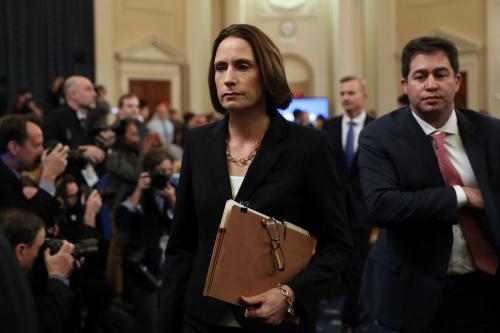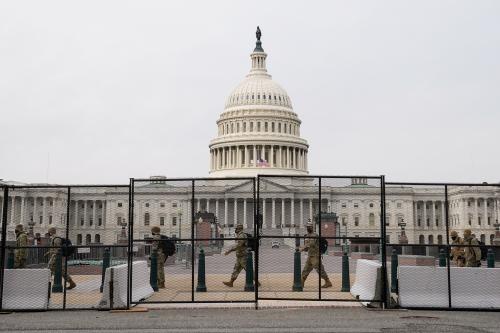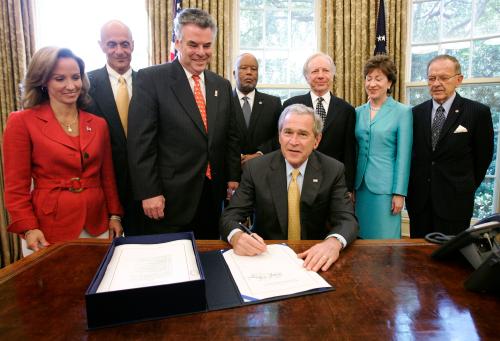I am pleased to appear before the Subcommittee today to consider options for strengthening the Office of Homeland Security. I believe this Subcommittee is right on target in asking whether and how the Office might improve the flow of information to and from key decision makers. Although there are many causes of the September 11 tragedy, none was so easily addressed as the failure to collect, interpret, and share information.
I believe the question of information sharing involves two discrete parts. First, is the federal government currently producing the right information? Second, is that information available to the right people at the right time?
The Immigration and Naturalization Service is a perfect case in point. It suffers from a dearth of high-quality information on potential threats to national security, and has serious vulnerabilities in making sure that high-quality information reaches the right people at the right time. Bluntly put, even if the agency were to discover a potential threat, it is not clear that the information would make it to key law enforcement and security officials in time to prevent a tragedy.
We know, for example, that the INS does not have the information technology to track visitors to the United States. The agency simply does not have the right information about who is entering the country under what conditions and for what purpose, nor does it know where current visitors might be located, or whether they have over-stayed their welcome. Although there is nothing the Office of Homeland Security can do at this point to better coordinate, share, or monitor information that does not exist, I believe there are ways that the Office can better control the production of information through expanded authority.
We also know that the INS does not have the technology to share the information it does have with the right people at the right time. We know, for example, that information about the individuals involved in the September 11 attacks on New York City and Washington, D.C., did not make it to the right people at the right time in the Immigration and Naturalization Service and its contractors. Otherwise, one would be hard pressed to explain last month’s extraordinary news that ACS, Inc., had mailed visa notices on behalf of Mohamed Atta and Marwan Al-Shehhi. Although one can argue that there was no harm, and, therefore, no foul, the lack of communication up and down the INS hierarchy speaks to the extraordinary problems in sharing information in a timely fashion.
Deja Vu
The INS is hardly the only federal agency with problems collecting and sharing the right information. Indeed, recent federal history is replete with examples of breakdowns caused by either bad information or good information ignored, including the security problems at the nation’s nuclear weapons laboratories and the taxpayer abuse at the Internal Revenue Service. Looking back with perfect hindsight, we can now see the outlines of a remarkable information breakdown at the core of the September 11 attacks, not the least of which were bits and pieces of evidence from flight schools and simulation centers. As in so many similar cases, from Pearl Harbor to Vietnam, we are likely to discover that the federal government had significant information about the potential threat, but could not put the pieces together in time.
The fact is that the federal government, indeed most organizations, almost always have the information to prevent failure, but not the analysis or communication chains. That was the case in the 1980s with the HUD Scandal and the Savings & Loan debacle, in the 1990s with espionage at the nuclear weapons labs and taxpayer abuse at the Internal Revenue Service, and the early 2000s with the INS. Sadly, I have made a living out of showing the problems associated with communication failures in the federal government. We see the same problems over and over and over again as information gets lost, distorted, mishandled, improperly classified, or misinterpreted up and down the ponderous federal hierarchy. See the appendix of this testimony for a side-by-side confirmation of my conclusion.
Assessing the Case at Hand
Our task today is not to look back for culprits, but to look forward to solutions. Simply asked by the Subcommittee, should the Office of Homeland Security have more power? As I and my colleagues at the Brookings Institution have argued, the answer is “yes.” Much as one can credit Governor Ridge with substantial success in shaping the budgets of the agencies involved in homeland security, his office does not provide the levers that are essential for coordinating, let alone assuring the flow of high-quality information in real time. He should be congratulated for having made the best of a very difficult situation, but should be fully empowered to make sure that the federal government has the information it needs.
Unfortunately, I do not believe Governor Ridge has the authority to prevent communication failures in the future. Even a cursory review of the Office of Homeland Security organization chart confirms the problem. According to the latest available Yellow Book listing, the Office is structured around an assortment of titles whose primary tasks focus more on outreach than information collection or analysis: (I have numbered the layers within the Office using conventional nomenclature.)
1. Assistant to the President for Homeland Security (Ridge)
2. Deputy Assistant to the President and Deputy Director
3. Deputy Assistant to the President (Communications & Legislative Affairs)
4. Deputy Assistant to the President for Legislative Affairs
Senior Associate Counsel to the President and General Counsel
5. Special Assistant and Senior Director for Information Integration and Chief Information Officer
Special Assistant and Senior Director for Policy & Plans
6. Special Assistant and Executive Secretary
Special Assistant for External Affairs
7. Protection & Prevention Senior Director
Response & Recovery Senior Director
8. Special Assistant and Director of Communications
9. Special Assistant for External Affairs
Special Assistant for Public Liaison
10. Assistant Director for Intergovernmental Affairs
11. Communication Strategy Director
12. Staff Assistant
Much as one might question the problems associated with twelve discrete layers in the Office, and much as one might ask whether the special assistant for information integration and chief information officer is (1) placed high enough in the bureaucratic pecking order, and (2) has too many competitors for access, the more important question at hand is whether Governor Ridge and his team have the authority needed to assemble the information they need. The answer appears to be “no.” At best, information collection and analysis is but one of many competing priorities in the Office of Homeland Security. At worst, it appears to reside in a single unit that has multiple responsibilities, not the least of which is ensuring that the Office itself has adequate computer technology, which is the traditional concern of chief information officer posts across government. At a minimum, I would recommend splitting the information integration and chief information officer posts, while raising the former to the level of deputy assistant to the president.
An Inventory of Authority
More importantly, however, I worry that the Office as currently constructed does not have the authority to implement an aggressive information collection, analysis, and dissemination strategy. Let me suggest the following problems facing the Office today:
- Production. The Office of Homeland Security does not have the authority to produce information that it deems essential to its planning process. Although it does have a talented, albeit small staff, the Office does not have the internal capacity to investigate or study problems that Governor Ridge deems essential. To the extent words have meaning, “coordinate” appears 33 times in the president’s executive order establishing the Office of Homeland Security, while the word “investigate” appears only once. “Study” and “analyze” do not appear at all.
Procurement. The Office of Homeland Security does not have the authority to order or purchase information, whether through private contractors such as the RAND Corporation, which has extraordinary capacity for conducting the kind of exploratory analysis that Governor Ridge might find particularly useful in anticipating potential threats, or through government intelligence agencies. Nor does the Office of Homeland Security have the dollars to make such purchases. If Governor Ridge wants a special analysis of trends across or within agency databases, one presumes he must ask.
Collection. The Office of Homeland Security appears to have adequate mechanisms for tapping into the federal government’s vast inventory of information. The question is whether an office composed of a scant 100 or so individuals, many of whom are dedicated to prevention, outreach, legislative affairs, communications, etc., can hope to swallow from the fire-hydrant of information that currently courses through government. I do not see, for example, the capacity to evaluate the quality of information flowing into the Office, nor do I see the ability to reach down into agencies to demand the release of information that already exists. Even more importantly, I do not see the capacity needed to compel the release of information that agencies might or might not know they have.
Quality. I do not see firm evidence that the Office of Homeland Security has the internal capacity to assay the quality of information flowing from inside or outside government. At least for the time-being, the Office must rely on its sources to validate information.
Analysis and Interpretation. The Office of Homeland Security does not appear to have adequate mechanisms for analyzing information. That might mean, for example, resolving disputes between different portraits of threats, or pulling strands of analysis together into a particular whole. Such analysis requires a much greater staffing complement that currently exists. By way of comparison, I would point the Subcommittee to the National Security Council staff, which contains a series of well-staffed directorates for monitoring international threats, as well as a well-developed administrative infrastructure. Although it is fair to argue that it has taken more than a half century to develop, the nation does not have another fifty years to wait. This problem is particularly significant given the Office’s role in maintaining the Homeland Security Advisory System, which assigns threats on a green (low) to red (highest) level.
Dissemination. The Office of Homeland Security appears to have adequate capability for disseminating information about potential threats.
Classification and Declassification. Although the Office of Homeland Security has ample authority to classify information as “top secret,” it does not have parallel authority to order the immediate declassification of information that it deems in the national interest.
Recommendations for Action
I do not believe statutory authority can solve all of these problems. However, it can improve the odds that the Office of Homeland Security can produce the right information at the right time. At a minimum, I strongly recommend that the Office be given the authority, and budget, needed to produce and procure its own analysis. Some may argue that such analysis would merely duplicate already existing information. I would argue to the contrary. The Office of Homeland Security has a special obligation to examine information through a very broad lens and from a vantage point that no other agency of government has.
I also strongly recommend that the Office be given enough staff to interpret, analyze, and assay the information that it currently receives, and to make recommendations to Congress and the President regarding improvements in the information system. That might mean, for example, that Congress would provide the funding for a minimum staff floor, or create a special information directorate within a new Office of Homeland Security. That might also mean that Congress would require the Office to conduct an information audit of the federal agencies it coordinates, and make recommendations regarding the technology investments needed to assure secure, high-quality information. Finally, I recommend that the director of Homeland Security be given limited authority to declassify information deemed in the public’s interest.
These authorities will be wasted, however, if the current Office or its statutory successor is allowed to thicken with needless bureaucracy. The thickening has already begun. Being lean and flat is not just a value that the president himself espoused in the 2000 presidential campaign; it is also the sine qua non for effective information sharing. For whatever reason, the current Office of Homeland Security has already become one of the thickest units in the White House. That not only weakens communication within the Office, it merely adds to the extraordinary thickening of other units of government. To the extent the president relies on Governor Ridge to stay in touch with the front-lines at the INS, for example, he is staring down an information chain with 30-35 links. That is more than the nation can afford.
Appendix
Layers to Los Alamos, Paul C. Light, July, 1999, The Washington Post
Blame Government Bloat for
Immigration Snafus,
Paul C. Light,
March, 2002,
USA Today



Commentary
TestimonyStrengthening the Office of Homeland Security
April 17, 2002